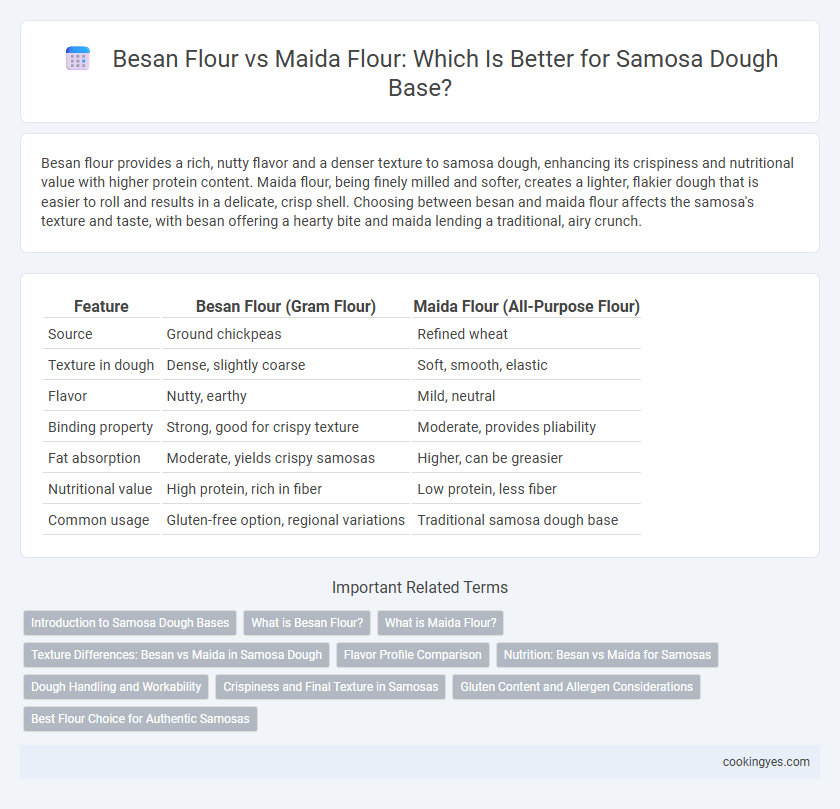Besan flour provides a rich, nutty flavor and a denser texture to samosa dough, enhancing its crispiness and nutritional value with higher protein content. Maida flour, being finely milled and softer, creates a lighter, flakier dough that is easier to roll and results in a delicate, crisp shell. Choosing between besan and maida flour affects the samosa's texture and taste, with besan offering a hearty bite and maida lending a traditional, airy crunch.
Table of Comparison
| Feature | Besan Flour (Gram Flour) | Maida Flour (All-Purpose Flour) |
|---|---|---|
| Source | Ground chickpeas | Refined wheat |
| Texture in dough | Dense, slightly coarse | Soft, smooth, elastic |
| Flavor | Nutty, earthy | Mild, neutral |
| Binding property | Strong, good for crispy texture | Moderate, provides pliability |
| Fat absorption | Moderate, yields crispy samosas | Higher, can be greasier |
| Nutritional value | High protein, rich in fiber | Low protein, less fiber |
| Common usage | Gluten-free option, regional variations | Traditional samosa dough base |
Introduction to Samosa Dough Bases
Samosa dough traditionally uses either besan flour or maida flour as the base, each affecting texture and flavor distinctly. Besan flour, made from ground chickpeas, offers a nutty taste and a denser, crispier crust, ideal for savory fillings. Maida flour, a refined wheat flour, produces a lighter, flakier texture, preferred for its softness and ease of folding the dough.
What is Besan Flour?
Besan flour, also known as gram flour, is made from ground chickpeas and is rich in protein and fiber, making it a nutritious alternative to maida flour for samosa dough. Unlike maida, which is refined wheat flour lacking fiber, besan flour adds a nutty flavor and crisp texture to the samosa crust. Its high binding properties help create a sturdy, golden-brown shell that holds the filling better during frying.
What is Maida Flour?
Maida flour, also known as refined wheat flour, is a highly processed white flour made from wheat endosperm stripped of bran and germ, resulting in a fine, soft texture ideal for pastry and bread making. Unlike besan flour, which is chickpea-based and gluten-free, maida contains gluten that provides elasticity and crispiness to samosa dough. Its neutral flavor and smooth consistency make maida flour the preferred choice for achieving a light, flaky, and golden samosa crust.
Texture Differences: Besan vs Maida in Samosa Dough
Besan flour creates a samosa dough with a denser, crumblier texture due to its high protein and fiber content, resulting in a more robust and slightly nutty crust. Maida flour, being finely milled and lower in protein, produces a softer, more elastic dough that crisps up with a lighter, flakier texture when fried. The choice between besan and maida significantly affects the samosa's dough structure, influencing both mouthfeel and frying characteristics.
Flavor Profile Comparison
Besan flour imparts a nutty, earthy flavor to samosa dough, enhancing the overall taste with its rich, slightly bitter undertones, while maida flour delivers a neutral, mild taste that allows the filling's flavors to dominate. The dense texture of besan also adds a subtle graininess, providing a more rustic mouthfeel compared to maida's smooth and soft finish. Choosing between besan and maida flour for samosa dough significantly influences the flavor profile, with besan offering a distinctive depth and maida ensuring a delicate, crisp bite.
Nutrition: Besan vs Maida for Samosas
Besan flour, made from ground chickpeas, offers higher protein content and richer fiber compared to maida flour, improving the nutritional value of samosa dough. Maida, refined wheat flour, contains more carbohydrates with less fiber and protein, leading to quicker digestion but lower satiety. Choosing besan flour for samosa dough enhances nutrient density and supports digestive health while maintaining a crispy texture.
Dough Handling and Workability
Besan flour creates a denser and more brittle dough, making it less pliable and trickier to roll out compared to maida flour. Maida flour offers superior elasticity and smoothness, resulting in easier dough handling and better workability for samosa wrappers. Choosing maida flour ensures a crispier texture and a more manageable dough during the shaping process.
Crispiness and Final Texture in Samosas
Besan flour in samosa dough enhances crispiness due to its higher protein content, creating a firm yet crunchy exterior that resists sogginess. Maida flour, being refined wheat flour, produces a softer, flakier texture with a lighter bite but tends to absorb oil more, affecting crispness. Combining besan and maida can balance the samosa's texture, offering both crunch and tenderness in the final product.
Gluten Content and Allergen Considerations
Besan flour, made from ground chickpeas, is naturally gluten-free and suitable for people with gluten intolerance or celiac disease, whereas maida flour contains high gluten content that provides elasticity and chewiness to samosa dough. The absence of gluten in besan flour results in a denser and crumblier dough, requiring additional binding agents for proper texture. For allergen considerations, besan flour is free from wheat-based allergens but may trigger legume allergies, while maida flour poses concerns for wheat allergies and gluten sensitivities.
Best Flour Choice for Authentic Samosas
Besan flour, rich in protein and fiber, enhances the authentic flavor and crispiness of samosa dough compared to maida flour, which is refined wheat flour with a smoother texture but less nutritional value. Using besan flour creates a sturdier, golden-brown crust that holds the filling well during frying, preserving the traditional taste and texture of samosas. Maida flour may result in a softer, less crispy outer layer, making besan the best flour choice for achieving genuine samosa quality.
Besan Flour vs Maida Flour for dough base Infographic

 cookingyes.com
cookingyes.com